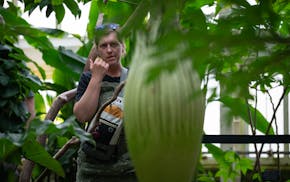Dr. Abdirahman Madar uses the same type of hand-held ultrasound device while training doctors at Hargeisa Group Hospital in Somaliland as when he sees patients in Minneapolis.
In Minnesota, the device is just one of many available diagnostic imaging tools. In Somaliland, it complements a single CT scanner as the hospital's only diagnostic imaging tool — and it can be a lifesaver.
Partnerships with Western doctors and medical organizations are essential in providing basic health care to the poorest citizens of developing nations. In Somalia, Madar and Dr. Max Fraden — both hospitalists with Hennepin Healthcare — provide that connection.
Madar and Fraden have coordinated funding and training for pilot projects at public hospitals that introduced the ultrasound devices, and they established a non-communicable disease clinic that has served about 1,100 patients so far. They hope the government of the semi-autonomous Somaliland region will eventually replicate the models at other public hospitals.
In Somaliland, the quality of health care is directly related to whether you can pay for it, Madar said. Private hospitals in Somaliland operate on an out-of-pocket system, and people often sacrifice food to spend $30 for an ultrasound or $120 for a CT scan, Fraden said.
Public hospitals, which serve the roughly one-third of the population that cannot afford to pay anything, are extremely underfunded, Madar said. In all of Somaliland, there are two or three MRI machines, all in private hospitals.
The lack of resources in his home country became clear to Madar in high school, after his father suffered a stroke. He entered medical school at Somali National University in Mogadishu, got his degree, and did basic surgical training through the International Committee of the Red Cross.
For five and a half years, Madar worked as a surgeon in Berbera, a coastal city in Somaliland, primarily taking care of people hurt in civil wars. When he won a spot in the U.S. Diversity Visa lottery in 1999, he and his family first moved to North Carolina and then relocated to Minneapolis in 2000 to join the larger Somali community here.
With most of his family still in Somalia, Madar stuck to his goal of improving health care in his homeland. He shared best practices with former colleagues overseas, and when COVID-19 struck in 2020 he founded the Somalilander American Health Association to send supplies and provide COVID education in Somaliland.
Fraden, meanwhile, had helped train doctors and nurses in Rwanda on portable ultrasound devices and non-communicable disease clinics. The imaging changed treatment in 43% of cases, according to a study of their use in low- and middle-income countries.
When the primary COVID threat passed, Madar and Fraden traveled to Somaliland together, where their projects were greeted with enthusiasm. They raised about $100,000, including money and equipment, and delivered the first eight ultrasound devices to Somaliland in April 2022.
Madar and Fraden conducted a four-week training series on using the ultrasound devices for 20 general practitioners at Hargeisa, a 250-bed facility for a city of 1.2 million. Some physicians traveled from rural areas to attend. "I teach residents here at Hennepin, and it's the same curriculum," Fraden said.
A pregnant mother with diabetes recently went to the hospital complaining of sudden shortness of breath, pain in her chest, a fast heart rate and a swollen right leg. Doctors used the handheld ultrasound device to confirm she had deep vein thrombosis with a pulmonary embolism, which can be life-threatening. Without the new devices, the doctors would have had to refer her to a private clinic.
Back in Minnesota, Madar and Fraden can review images and diagnoses from their colleagues at Hargeisa with software that allows users to add comments to images via WhatsApp. "It's a really nice way for people to learn," Fraden said.
The doctors returned to Somaliland to open the first non-communicable disease clinic there, treating people with conditions such as diabetes, high blood pressure and chronic kidney disease. Amputations and death due to diabetes are common in Somaliland, due to lack of education about the disease and inability to afford regular health care. The mean age of heart failure in sub-Saharan Africa is 52 years — two decades younger than in western countries.
About 30% of mortality in Somalia is attributed to non-communicable diseases, Fraden said, even though such diseases historically have been associated with more affluent countries. At the new clinic, patients get free insulin and other medications, and are taught how to manage their conditions.
"If someone has diabetes in the U.S., you can live with it," Madar said. "But in Somalia, you don't live with it."
One early indicator of success is that the clinic is outgrowing its physical space, said Dr. Ahmed Hirsi, who works at the hospital in Hargeisa. "We need a new building to expand our capacity," he said.
Fraden said he's eager to start a project focusing on hepatitis C, which affects about 5% of the population in Somalia. In the United States, medication can eliminate the disease within 8 to 12 weeks; in Somaliland, you can't get treatment, he said.
If it's up to Madar and Fraden, however, that won't be the case for long: once enough money is raised, Fraden plans to go back in November to start work on the project.
About the partnership
This story comes to you from Sahan Journal, a nonprofit newsroom dedicated to covering Minnesota's immigrants and communities of color. Sign up for a free newsletter to receive Sahan's stories in your inbox.

Robert Downey Jr. spotted at downtown Minneapolis Target

Como Park's corpse flower is starting to stink — here's how to watch it bloom

Tornado watch canceled early in south Twin Cities metro

